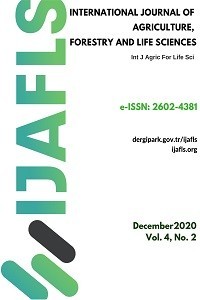Rapid detection of green pea adulteration in ground pistachio nuts using near and mid-infrared spectroscopy
Rapid detection of green pea adulteration in ground pistachio nuts using near and mid-infrared spectroscopy
Adulteration chemometrics, green pea, mid-infrared, near-infrared, pistachio,
___
- Aboul-Enein, Y., Bunaciu, A., & Fleschin, S. (2014). Evaluation of the protein secondary structures using Fourier Transform Infrared Spectroscopy. Gazi University Journal of Science, 27(1), 637-644.
- Asensio, L., González, I., García, T., & Martín, R. (2008). Determination of food authenticity by enzyme-linked immunosorbent assay (ELISA). Food Control, 19(1), 1-8.
- Barth, A. (2007). Infrared spectroscopy of proteins. Biochimica et Biophysica Acta (BBA)-Bioenergetics, 1767(9), 1073-1101.
- Bulló, M., Juanola-Falgarona, M., Hernández-Alonso, P., & Salas-Salvadó, J. (2015). Nutrition attributes and health effects of pistachio nuts. British Journal of Nutrition, 113(S2), S79-S93.
- Cautela, D., Laratta, B., Santelli, F., Trifirò, A., Servillo, L., & Castaldo, D. (2008). Estimating bergamot juice adulteration of lemon juice by high-performance liquid chromatography (HPLC) analysis of flavanone glycosides. Journal of Agricultural and Food Chemistry, 56(13), 5407-5414.
- Çağlar, A., Tomar, O., Vatansever, H., & Ekmekçi, E. (2017). Antepfıstığı (Pistacia vera L.) ve insan sağlığı üzerine etkileri. Akademik Gıda, 15(4), 436-447.
- Çavuş, F., Us, M. F., & Güzelsoy, N. A. Assesing Pistachio Nut (Pistacia vera L.) Adulteration with Green Pea (Pisum sativum L.) by Untargeted Liquid Chromatography-(quadrupole-time of flight)-Mass Spectrometry Method and Chemometrics. Gıda ve Yem Bilimi Teknolojisi Dergisi, (19), 34-41.
- Chavan, U. D., Shahidi, F., Bal, A. K., & McKenzie, D. B. (1999). Physico-chemical properties and nutrient composition of beach pea (Lathyrus maritimus L.). Food Chemistry, 66(1), 43-50.
- Cuadrado, M. U., De Castro, M. L., Juan, P. P., & Gómez-Nieto, M. A. (2005). Comparison and joint use of near infrared spectroscopy and Fourier transform mid infrared spectroscopy for the determination of wine parameters. Talanta, 66(1), 218-224.
- Dreher, M. L. (2012). Pistachio nuts: composition and potential health benefits. Nutrition reviews, 70(4), 234-240.
- Eksi-Kocak, H., Mentes-Yilmaz, O., & Boyaci, I. H. (2016). Detection of green pea adulteration in pistachio nut granules by using Raman hyperspectral imaging. European Food Research and Technology, 242(2), 271-277.
- Guo, H., Kimura, T., & Furutani, Y. (2013). Distortion of the amide-I and-II bands of an α-helical membrane protein, pharaonis halorhodopsin, depends on thickness of gold films utilized for surface-enhanced infrared absorption spectroscopy. Chemical Physics, 419, 8-16.
- Htoon, A., Shrestha, A. K., Flanagan, B. M., Lopez-Rubio, A., Bird, A. R., Gilbert, E. P., & Gidley, M. J. (2009). Effects of processing high amylose maize starches under controlled conditions on structural organisation and amylase digestibility. Carbohydrate Polymers, 75(2), 236-245.
- Jouppila, K., Kansikas, J., & Roos, Y. H. (1998). Factors affecting crystallization and crystallization kinetics in amorphous corn starch. Carbohydrate Polymers, 36(2-3), 143-149.
- Kashaninejad, M., & Tabil, L. G. (2011). Pistachio (Pistacia vera L.). In: Postharvest biology and technology of tropical and subtropical fruits. (Woodhead Publishing, 218-247).
- Kropf, U., Golob, T., Nečemer, M., Kump, P., Korošec, M., Bertoncelj, J., & Ogrinc, N. (2010). Carbon and nitrogen natural stable isotopes in Slovene honey: adulteration and botanical and geographical aspects. Journal of Agricultural and Food Chemistry, 58(24), 12794-12803.
- Küçüköner, E., & Yurt, B. (2003). Some chemical characteristics of Pistacia vera varieties produced in Turkey. European Food Research and Technology, 217(4), 308-310.
- MacMahon, S., Begley, T. H., Diachenko, G. W., & Stromgren, S. A. (2012). A liquid chromatography–tandem mass spectrometry method for the detection of economically motivated adulteration in protein-containing foods. Journal of Chromatography A, 1220, 101-107.
- Pu, Y.Y., O’Donnell, C., Tobin, J., & O’Shea, N. (2020). Review of near-infrared spectroscopy as a process analytical technology for real-time product monitoring in dairy processing. International Dairy Journal (In Press).
- Ratnayake, W. S., Hoover, R., & Warkentin, T. (2002). Pea starch: composition, structure and properties—a review. Starch‐Stärke, 54(6), 217-234.
- Rodriguez-Saona L., Ayvaz H., Wehling R.L. (2017) Infrared and Raman Spectroscopy. In: Nielsen S. (eds) Food Analysis. Food Science Text Series. (Springer, Cham, 107-127).
- Rodriguez-Saona, L. E., Giusti, M. M., & Shotts, M. (2016). Advances in infrared spectroscopy for food authenticity testing. In Advances in food authenticity testing (pp. 71-116). Woodhead Publishing.
- Ruiz-Matute, A. I., Soria, A. C., Martínez-Castro, I., & Sanz, M. L. (2007). A new methodology based on GC− MS to detect honey adulteration with commercial syrups. Journal of Agricultural and Food Chemistry, 55(18), 7264-7269.
- Tiwari, B. K., Brunton, N. P., & Brennan, C. (2013). Handbook of plant food phytochemicals: sources, stability and extraction. John Wiley & Sons.
- Tulbek, M. C., Lam, R. S. H., Asavajaru P., & Lam, A., (2017). Pea: A sustainable vegetable protein crop. In: Sustainable protein sources. (Academic Press, 145-164).
- Valand, R., Tanna, S., Lawson, G., & Bengtström, L. (2020). A review of Fourier Transform Infrared (FTIR) spectroscopy used in food adulteration and authenticity investigations. Food Additives & Contaminants: Part A, 37(1), 19-38.
- Williams, P.C. (2001). Implementation of near-infrared technology. In: Near-Infrared Technology in the Agricultural and Food Industries. (American Association of Cereal Chemists, Minnesota, 145-169).
- Zhao, Y., Zhang, B., Chen, G., Chen, A., Yang, S., & Ye, Z. (2014). Recent developments in application of stable isotope analysis on agro-product authenticity and traceability. Food chemistry, 145, 300-305.
- Yayın Aralığı: Yılda 2 Sayı
- Başlangıç: 2017
- Yayıncı: Volkan OKATAN
Essential oil content and composition of Cotinus coggygria Scop. from Hatay, Turkey
Fitri RACHMAWATİ, Dewi PRAMANİK, Budi WİNARTO
Zeynep ERGUN, Mozhgan ZARIFIKHOSROSHAHI
Hridesh SHARMA, Sandeep CHAPAGAİN, Sudeep MARASİNİ
Recent developments of industrıal enzyme production in food biotechnology
